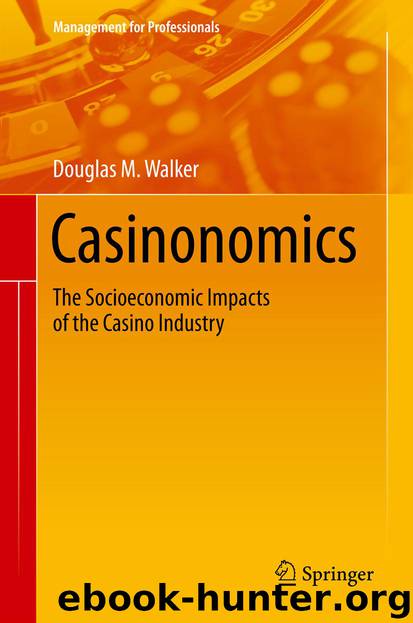Casinonomics by Douglas M. Walker

Author:Douglas M. Walker
Language: eng
Format: epub
Publisher: Springer New York, New York, NY
11.5 Discussion and Conclusion
The analysis in this chapter focuses on the relationship of retrospective reports of childhood ADHD symptoms to gambling behaviors in young adults. Analysis of the Add Health data provided evidence, indicating that youths who reported symptoms consistent with Hyperactive–Impulsive type ADHD from ages 5 to 12 years were significantly more likely than those without those ADHD symptoms to later report clinical characteristics of disordered gambling, large past-year losses and/or multiple forms of gambling as young adults (ages 18–27). However, those individuals who reported symptoms similar to those for Inattentive type ADHD were significantly less likely than those without those symptoms to later report symptoms associated with disordered gambling. We find no relationship between Combined type ADHD symptoms and the gambling behaviors we examined.
This study lends limited support to the relationship of the Hyperactive–Impulsive subtype of ADHD to gambling behavior. It is the first investigation of these relationships in a large, nationally representative sample of young adults, adding to the existing literature which is primarily derived from small samples and clinical populations of gamblers or youths with ADHD. These findings suggest that the impulsivity and hyperactivity characteristic of a subset of youths with ADHD symptoms may be related to the impulse dyscontrol characteristic of disordered gambling. Conceptually, the behavioral reinforcement schedule of gambling, combined with the sensory and mental stimulation of select games, should appeal to youth with hyperactive features. In addition, youths characterized by impulsivity should also be at increased risk for disordered gambling, because the inability to delay gratification and/or engage in reasoned decision-making in the face of mounting losses could lead to gambling problems. Similarly, there is a dissociative phenomenon that occurs with passive forms of gambling like video games that also require the ability to sit and attend to a machine over time. Those who are inattentive would likely lack the drive and/or the focus to engage in either form of gambling behavior for a significant period of time, becoming bored with passive forms of gambling and too distracted when playing action games that require focus and recall to play. These findings are consistent with prior studies that examined linkages among ADHD subtypes and disordered gambling, and highlight the need to uniformly examine comorbidity by subtypes to avoid misleading findings, e.g., see Breyer et al. (2009).
Replication studies with diverse samples are necessary to confirm findings due to three main limitations of this study. As discussed, the gambling indicators were identified based on their similarity to questions utilized in clinical diagnostic instruments. It is unknown whether results would differ had the Add Health questions included actual diagnostic criteria that would have provided a complete measure of gambling problem severity. In addition, the answers were not based on a diagnostic assessment of the participants but, rather, on respondent self-reporting which may not accurately reflect findings in a clinical assessment. Similarly, ADHD symptomatology was assessed retrospectively by asking participants to recall and identify symptoms and behavior from ages 5 to 12, the responses are limited by the
Download
This site does not store any files on its server. We only index and link to content provided by other sites. Please contact the content providers to delete copyright contents if any and email us, we'll remove relevant links or contents immediately.
International Integration of the Brazilian Economy by Elias C. Grivoyannis(90772)
The Radium Girls by Kate Moore(11921)
Turbulence by E. J. Noyes(7935)
Nudge - Improving Decisions about Health, Wealth, and Happiness by Thaler Sunstein(7615)
The Black Swan by Nassim Nicholas Taleb(7010)
Rich Dad Poor Dad by Robert T. Kiyosaki(6399)
Pioneering Portfolio Management by David F. Swensen(6226)
Man-made Catastrophes and Risk Information Concealment by Dmitry Chernov & Didier Sornette(5921)
Zero to One by Peter Thiel(5684)
Secrecy World by Jake Bernstein(4643)
Millionaire: The Philanderer, Gambler, and Duelist Who Invented Modern Finance by Janet Gleeson(4374)
The Age of Surveillance Capitalism by Shoshana Zuboff(4209)
Skin in the Game by Nassim Nicholas Taleb(4161)
Bullshit Jobs by David Graeber(4094)
The Money Culture by Michael Lewis(4075)
Skin in the Game: Hidden Asymmetries in Daily Life by Nassim Nicholas Taleb(3929)
The Dhandho Investor by Mohnish Pabrai(3698)
The Wisdom of Finance by Mihir Desai(3650)
Blockchain Basics by Daniel Drescher(3500)
